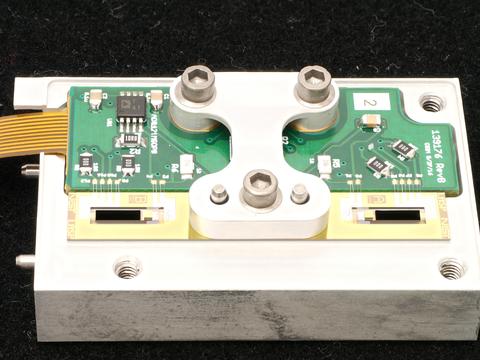Chip-Scale Bolometer and Related Technologies

The Technology
NIST researchers are developing the next generation of high-accuracy, chip-scale power metering technologies for a range of present and future needs. All are based to some degree on NIST’s patented 2013 electrical substitution bolometer design, which uses an array of vertically aligned ultra-black carbon nanotubes (VACNTs) that absorb more than 99% of the energy of incident radiation.
One team has created a miniaturized system to measure the power of signals traveling in fiber-optic lines, which are attenuated over distance and require repeaters at intervals. That power has been difficult to measure accurately against a primary reference standard traceable to the SI.
NIST’s Cryogenic Optical Fiber Power Meter is a primary standard that operates at 7.6 K, comprising two silicon micro-machined planar detectors, with VACNT absorbers, thin film tungsten heaters and superconducting resistive transition edge temperature transducers.
Another project has produced a suite of lightweight, chip-scale meters to measure the Sun’s total irradiance — the amount of optical power that arrives at Earth per unit area — and wavelength spectrum from space. That information, which is critically necessary for climate science among other applications, has conventionally been obtained by instruments on large satellites.
Other NIST researchers have developed a new chip-scale bolometer for calibrating low-power, continuous-wave lasers in the range of 500 µW to 1 W, with uncertainty of 0.3% or less.
In a related NIST project, researchers constructed a bolometer designed for extremely fast measurements of infrared (IR) radiation, providing in-house capability for the Air Force Metrology and Calibration Program to help ensure reliable performance of its air and space systems.
Advantages Over Existing Methods
The Cryogenic Optical Fiber Power Meter is the first such device to implement a chip-based, directly traceable measurement of optical fiber power with reduced size, greater accuracy and a 20% improvement in uncertainty over previous designs.
For space applications, NIST is collaborating with the Laboratory for Atmospheric and Space Physics (LASP) at the University of Colorado Boulder to build the Compact Total Irradiance Monitor. Using silicon micromachining and employing clusters of carbon nanotubes as the absorbing element, it will provide the highest accuracy ever achieved for space-based solar irradiance measurements with much lower mass and much smaller dimensions than any detector currently in orbit.
As a result, highly accurate measurements can be made from miniaturized “CubeSats” only a few tens of centimeters on a side, providing a continuous stream of weather and climate data while greatly reducing the cost of these missions.
Applications
The ability to measure the power of all kinds of electromagnetic radiation is crucial for calibrating equipment for optical telecommunications and medical imaging; gauging laser power; tracking the onset and spread of forest fires via IR detection; conducting infrared surveillance on the ground and in the sky; and recording both faint flickers of light from far outer space and total solar irradiance.
Key Papers
N.A. Tomlin, C.S. Yung, Z. Castleman, M. Denoual, G. Drake, N. Farber, D. Harber, K. Heuerman, G. Kopp, H. Passe, E. Richard, J. Rutkowski, J. Sprunck, M. Stephens, C. Straatsma, S. Van Dreser, I. Vayshenker, M.G. White, S.I. Woods, W. Zheng and J.H. Lehman. Overview of microfabricated bolometers with vertically aligned carbon nanotube absorbers. AIP Advances. May 7, 2020. DOI: 10.1063/5.0004025
M.G. White, E. Baumann, I. Vayshenker, Z.E. Ruiz, M.S. Stephens, M. Smid and J.H. Lehman. Nature of fiber-coupled detector responsivity measurements at 0.1% using a primary standard. Optics Express. May 5, 2020. DOI: 10.1364/OE.393064
A. Vaskuri, M.S. Stephens, N.A. Tomlin, C.S. Yung, A.J. Walowitz, C. Straatsma, D. Harber and J.H. Lehman. Microfabricated bolometer based on a vertically aligned carbon nanotube absorber. Proceedings Volume 11269, Synthesis and Photonics of Nanoscale Materials XVII, SPIE LASE. March 2, 2020. DOI: 10.1117/12.2545254
E. Richard, D. Harber, G. Drake, J. Rutkowski, Z. Castleman, M. Smith, J. Sprunck, W. Zheng, P. Smith, M. Fisher, A. Sims, B. Cervelli, M. Chambliss, T. Woods, P. Pilewskie, C. Yung, M. Stephens, N. Tomlin, M. White and J. Lehman. Compact spectral irradiance monitor: Flight demonstration mission. Proceedings SPIE 11131, CubeSats and SmallSats for Remote Sensing III. Aug. 30, 2019. DOI: 10.1117/12.2531268
C.S. Yung, N.A. Tomlin, C. Straatsma, J. Rutkowski, E.C. Richard, D.M. Harber, J.H. Lehman and M.S. Stephens. BABAR: black array of broadband absolute radiometers for far infrared sensing. Proceedings of SPIE 10980, Image Sensing Technologies: Materials, Devices, Systems, and Applications VI. May 13, 2019. DOI: 10.1117/12.2516047
N.A. Tomlin, M. White, I. Vayshenker, S.I. Woods and J.H. Lehman. Planar electrical-substitution carbon nanotube cryogenic radiometer. Metrologia. March 30, 2015. DOI: 10.1088/0026-1394/52/2/376
M.G. White, Z.E. Ruiz, C.S. Yung, I. Vayshenker, N.A. Tomlin, M.S. Stephens and J.H. Lehman. Cryogenic primary standard for optical fibre power measurement. Metrologia. Aug. 17, 2018. DOI: 10.1088/1681-7575/aad658
Z.C.D. Harber, G. Drake, K. Heuerman, G. Kopp, J. Rutkowski, H. Passe, M. Smith, P. Smith, J. Sprunck, E. Richard, N. Tomlin, M. Stephens, M. White, C. Yung and J. Lehman. New Generation Bolometric Detector for Measurement of Solar Spectral Irradiance. 97th American Meteorological Society Annual Meeting. Jan. 24, 2017.
Key Patents
J. Lehman et al. Radiometer and method for use of same. United States Patent US 9,291,499. March 22, 2016.
Contacts
-
(303) 497-3654

